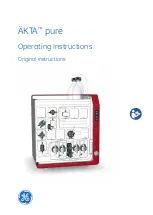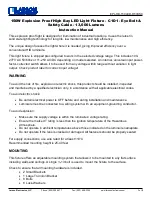
User Manual
Page 9 of 22
Version 1.2
7.2
Technical Data of Hydraulic Resistance Encoder
Length (boss to boss)
:
580 Mm
Maximum levitation height
:
210 Mm
maximum width
:
78 Mm
Width of boss
:
20 Mm
Width connecting link
:
25 Mm
Bracing
:
70 N
Maximum force
:
4 KN
Damping consistence
:
Silicon Oil
Supply voltage
:
6 V (DC)
Burst pressure Cylinder
:
320 Bar
Maximum pressure seal
:
60 Bar
System pressure
:
2 - 15 Bar
7.3
Special safety Instructions for the Hydraulic Resistance System
Maintenance may only be conducted by authorized persons appointed by proxomed. During servicing
wearing of protective eyewear is mandatory. Due to the technical structure of the damper during
maintenance a spontaneous and explosive pressure could be released. The filling pressure is 3.5bar.
The user is responsible to ensure that the damper is not nudged to the frame or components of the
equipment, if it is replaced or assembled. The clearance should be checked over the entire levitation length
of the damper!
The mounting screws must be checked periodically for tightness.
The hydraulic resistance system changes its resistance characters depending on the training speed.
For faster training speed is a higher impact to be performed. This fact needs to be taken in
account during training.
8
Exercise Guidance and Technical Data for the Training Devices
The positioning of the customer needs always to be done with utmost care, because quality and effectiveness of the
exercise performance are highly dependent on a correct starting position.
On most devices training is performed in a sitting or semi-standing position. The back, especially the lumbar spine,
should be stabilized as much as possible during the exercise. The devices axes and pivot points must be adjusted as
closely as possible to the axes of the respective joints to prevent the occurrence of compression and shear forces. The
resistance should be chosen that the client / trainee can perform the training without evasive movements. The load
change is made by the resistance system mounted wheel knob.
8.1
Common Training Advices
Before starting to train the customer should, for example, warm up on a cycle ergometer followed by stretching
exercises and preparing the appropriate muscles to the upcoming load.
If symptoms occur, the exercise needs to be stopped and if necessary the doctor needs to be consulted.
The devices enable customers to do a concentric / concentric training and to avoid high eccentric stress on muscles.
The movement should be slow and controlled, making sure that the correct motion is performed. The exercise
intensity should be chosen at the start of training, which should be light. The load can then be increased gradually to
avoid congestion that can cause problems and pain for the customer / training person.








































